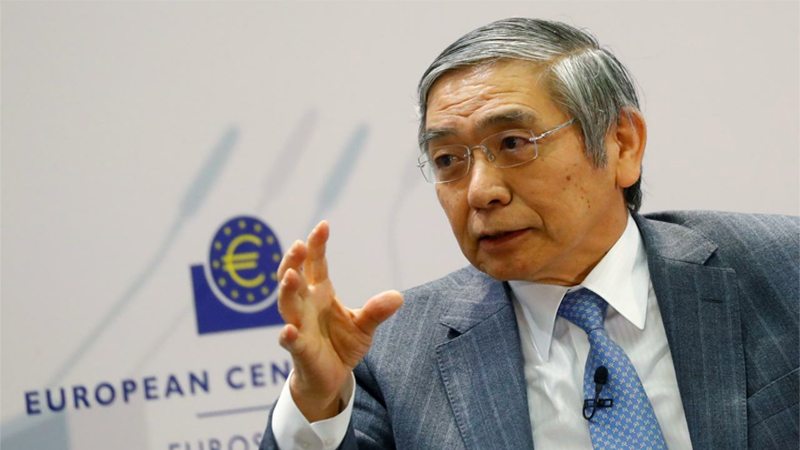Modest Bank of Japan move could spark major market flows


LONDON: The era of super-cheap money is ending, and stocks’ remarkable run to new highs and bond yields’ refusal to shoot higher suggest world markets are taking this seismic monetary policy shift in their stride.
Yet while attention is fixed on the US Federal Reserve, European Central Bank and Bank of England, a wake-up call for investors could come from an unlikely source: Japan.
The Bank of Japan is dropping subtle hints that it could edge away from crisis-mode stimulus earlier than expected by tweaking its “yield curve control” (YCC) policy, essentially allowing longer-term yields to rise. Taking its foot off the easing pedal, however slowly or lightly, has potentially huge implications for global markets due to the vast amount of Japanese cash invested overseas.
According to the latest Ministry of Finance data, Japanese investors hold 453 trillion yen ($4.08 trillion) of foreign portfolio investments – 282 trillion yen ($2.54 trillion) of bonds and 171 trillion yen ($1.54 trillion) in stocks and funds.
On top of that, Japan has $1.3 trillion of foreign exchange reserves, mostly parked in US bonds.
Of Japan’s portfolio investments overseas, some $1.7 trillion is in US stocks and $1.2 trillion in US bonds. Next is Europe, with $300 billion in stocks and $845 billion in debt securities. In their hunt for yield, Japanese investors have left no stone unturned. Their biggest European bond holdings are in France ($265 billion), well ahead of second-placed Britain ($175 bln) and third-placed Germany ($130 bln).
These markets are less liquid than US Treasuries, so potentially more vulnerable to Japanese retrenchment.
Japan’s net international investment position is worth 64 percent of the country’s annual gross domestic product, according to Morgan Stanley. That means Japanese investors hold around $3.2 trillion more foreign assets than overseas investors hold in Japan, making Japan the world’s biggest international creditor in nominal terms.
The prospect of higher domestic returns could stem the flow of investment abroad or even reverse some of it, should the BOJ try to engineer a steeper yield curve.
As Bank of New York Mellon’s Neil Mellor notes: “There can be no question of an imminent change to policy … (which) could have momentous repercussions.”
Interest rates in Japan have been falling for nearly 30 years although the BOJ did hike them in 2000 and 2006-07, the latter period was when the Fed and other central banks were tightening. Both BOJ tightenings were deemed policy errors.
From the big banks to “Mrs Watanabe’s” investments via pension and insurance funds, Japan’s footprint on world markets has grown over the past 25 years as persistently low interest rates and yields at home have pushed money abroad.
Japanese interest rates and bond yields have long been among the world’s lowest. The BOJ’s benchmark interest rate has been negative for nearly two years and its overnight target rate has been just 0.10 percent for eight years – the last time it was higher than 0.5 percent was two decades ago.
Two key variables determining Japanese investors’ appetite for investing abroad are the nominal level of US yields and steepness of the US yield curve. Higher US yields and a steeper curve are more attractive to Japanese investors.
Benchmark 10-year US yields are 2.34 percent, well above Japan’s, which have hovered around the BOJ’s explicit target of zero since it was introduced in September last year.
The US yield curve, the gap between two- and 10-year yields, is the flattest in a decade, below 60 basis points. At the current pace, an inverted curve – the classic red flag that recession is looming – will come early next year.
Japan’s yield curve is much flatter — below 20 basis points. But it wouldn’t take much steepening of the Japanese curve and continued flattening of the US curve for that difference to narrow then flip.
The relationship between the US yield curve and Japanese purchases of US bonds is instructive. According to Reuters calculations from MOF data, Japanese investors bought a modest $23 billion of US bonds in 2014, a year in which the US yield curve flattened a hefty 115 basis points. In 2015 the curve flattened only 28 basis points and Japanese investors bought $117 billion of US bonds. Last year when the curve steepened 3 basis points they bought $125 billion.
So far this year the curve has flattened 65 bps and they’ve sold $1 billion, a trifling amount in nominal terms but a rare reversal of the typical flow into US bonds. There’s a certain paradox attached to the BOJ. It’s been at the vanguard of central bank experimentation and unorthodoxy for around quarter of a century, deploying large scale asset purchases, zero interest rates, and yield targeting in a near-constant battle against deflation. Where it has led, others have followed.
Published in Daily Times, November 30th 2017.
Recent Posts
- Pakistan
Mohsin naqvi demands neutral probe into Pahalgam attack
Interior Minister Mohsin Naqvi demanded an independent investigation into the Pahalgam incident. He said Pakistan…
- World
US-Ukraine leaders meet in Rome: Productive talks on ending Ukraine-Russia conflict
US President Donald Trump and Ukrainian President Volodymyr Zelenskiy held a “very productive” meeting in…
- Pakistan
Sindh braces for heatwave until april 30
The Pakistan Meteorological Department (PMD) has warned that most parts of Sindh will face a…
- Pakistan
Imran Khan attack: Main accused sentenced to life imprisonment
In a significant development, a special anti-terrorism court (ATC) in Gujranwala has sentenced the prime…
- Sports
Abrar Ahmed credits PSL for white-ball success and growth
Mystery spinner Abrar Ahmed, representing Quetta Gladiators in HBL PSL, credits the tournament for his…
- Business
SBP governor reassures global investors on Pakistan’s economic stability
The Governor of the State Bank of Pakistan (SBP), Jameel Ahmad, reassured global investors about…
Leave a Comment